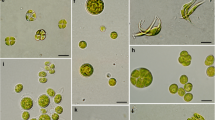Abstract
The capacity for chemoautotrophic, mixotrophic and organotrophic growth in the dark was tested with 45 strains of 17 species (11 genera) of the Chromatiaceae. The auxanographic deep agar shake culture method was used; the gas phase contained 5% O2 and 1% CO2 in N2. All strains tested of Chromatium vinosum, C. minus, C. violascens, C. gracile, Thiocystis violacea, Amoebobacter roseus, Thiocapsa roseopersicina gave positive growth responses under chemoautotrophic and mixotrophic conditions (extra carbon source acetate); one strain of Thiocapsa roseopersicina grew also organotrophically on acetate alone. No growth was obtained with the remaining 17 strains of ten species. None of the five type species (three genera) of the Chlorobiaceae grew under chemotrophic conditions. With Thiocystis violacea 2311 a growth yield of 11.3g dry weight per mol thiosulfate consumed was obtained under chemoautotrophic conditions; under mixotrophic conditions with acetate the yield increased to 69g dry weight per mol thiosulfate consumed. With Thiocystis violacea 2311 maximal specific respiration rates were obtained with thiosulfate as electron donor irrespective of the presence or absence of sulfur globules in the cells; organic substrates served as carbon sources only and did not support respiration. With Chromatium vinosum D utilization of thiosulfate was not constitutive; maximal respiration rates on thiosulfate were obtained only with thiosulfate grown cells containing sulfur globules. Respiration rates were further increased by malate, fumarate or propionate; these substrates also served as sole electron donors for respiration. Acetate and pyruvate were used as carbon sources only. The ecological significance of the chemotrophic metabolism is discussed.
Similar content being viewed by others
References
Badziong, W., Thauer, R. K., Zeikus, J. G.: Isolation and characterization of Desulfovibrio growing on hydrogen plus sulfate as the sole energy source. Arch. Microbiol. 116, 41–50 (1978)
Biebl, H., Pfennig, N.: Growth yields of green sulfur bacteria in mixed cultures with sulfur and sulfate reducing bacteria. Arch. Microbiol. 117, 9–16 (1978)
Bogorov, L. V.: About the properties of Thiocapsa roseopersicina strain BBS, isolated from the estuary of the White Sea. Microbiologiya 43, 326–332 (1974)
Breuker, E.: Die Verwertung von intrazellulärem Schwefel durch Chromatium vinosum im aeroben und anaeroben Dunkelstoffwechsel. Zbl. Bakt., II. Abt. 118, 561–579 (1964)
Cohn, E. G.: Behaviour of Vibrio fetus in relation to O2. Universidad do Brasil, Rio de Janeiro. An. Microbiol. 10, 147–171 (1962)
Dijken, I. P. van, Harder, W.: Growth yields of microorganisms on methanol and methane: A theoretical study. Biotechnol. Bioeng. 17, 15–30 (1975)
Drews, G., Lampe, H.-H., Ladwig, R.: Die Entwicklung des Photosyntheseapparates von Rhodopseudomonas capsulata. Arch. Mikrobiol. 65, 12–28 (1969)
Fredette, V., Planté, C., Roy, A.: Numerical data concerning the sensitivity of anaerobic bacteria to oxygen. J. Bacteriol. 94, 2012–2017 (1967)
Gemerden, H. van: On the ATP generation by Chromatium in darkness. Arch. Mikrobiol. 64, 118–124 (1968)
Gibson, J.: Aerobic metabolism of Chromatium sp. strain D. Arch. Mikrobiol. 59, 104–112 (1967)
Göbel, F.: Direct measurements of pure absorbance spectra of living phototrophic microorganisms. Biochim. Biophys. Acta (Amst.) 538, 593–602 (1978)
Gorlenko, V. M.: The oxidation of thiosulfate of Amoebobacter roseus in the dark under microaerophilic conditions. Mikrobiologiya 43, 729–731 (1974)
Hempfling, W. P., Vishniac, W.: Yield coefficients of Thiobacillus neapolitanus in continuous culture. J. Bacteriol. 93, 874–878 (1967)
Hurlbert, R. E.: Effect of oxygen on viability and substrate utilization in Chromatium. J. Bacteriol. 93, 1346–1352 (1967)
Justin, P., Kelly, D. P.: Growth kinetics of Thiobacillus denitrificans in anaerobic and aerobic chemostat culture. J. Gen. Microbiol. 107, 123–130 (1978)
Kondratieva, E. N., Zhukov, V. G., Ivanovsky, R. N., Petushkova, Yu. P., Monosov, E. Z.: The capacity of phototrophic sulfur bacterium Thiocopsa roseopersicina for chemosynthesis. Arch. Microbiol. 108, 287–292 (1976)
Niel, C. B. van: The bacterial photosynthesis and their importance for the general problem of photosynthesis. Advanc. Enzymol. 1, 263–328 (1941)
Pfennig, N.: Dark growth phototrophic bacteria under microaerophilic conditions. J. Gen. Microbiol. 61, ii-iii (1970)
Pfennig, N.: The phototrophic bacteria and their role in the sulfur cycle. Plant Soil 43, 1–16 (1975)
Pfennig, N., Siefert, E.: Metabolism of C1-compounds by Rhodopseudomonas acidophila. In: Abstracts of the Second International Symposium “Microbial growth on C1-compounds”, pp. 146–147. Pushchino, USSR, 1977
Pfennig, N.: General physiology and ecology of photosynthetic bacteria. In: The photosynthetic bacteria (Clayton, R. C., Sistrom, W. R., eds.), pp. 3–18, New York: Plenum Press 1978
Siefert, E.: Aerobes Wachstum von Rhodopseudomonas mit Wasserstoff oder Methanol im Dunkeln. Zbl. Bakt. Hyg., I. Abt. Ref. 256, 409 (1978)
Siefert, E., Irgens, R. L., Pfennig, N.: Phototrophic purple and green bacteria in a sewage treatment plant. Appl. Environ. Microbiol. 35, 38–44 (1978)
Siefert, E., Pfennig, N.: Chemoautotrophic growth of Rhodopseudomonas species with hydrogen and chemotrophic utilization of methanol and formate. Arch. Microbiol. 122, 177–182 (1979)
Smith, A. J., Lascelles, J.: Thiosulfate metabolism and rhodanese in Chromatium D. J. Gen. Microbiol. 42, 357–370 (1966)
Sorokin, Yu. I.: Role of carbon dioxide and acetate in biosynthesis of sulfate reducing bacteria. Nature (Lond.) 210, 551–552 (1966)
Sorokin, Yu. I.: Interrelations between sulfur and carbon turnover in meromictio lakes. Arch. Hydrobiol. 66, 391–446 (1970)
Thiele, H. H.: Die Verwertung einfacher organischer Substrate durch Thiorhodaceae. Arch. Mikrobiol. 60, 124–138 (1968)
Vries, H. de, Stouthamer, A. H.: Factors determing the degree of anaerobiosis of Bifidobacterium strains. Arch. Mikrobiol. 65, 275–287 (1969)
Author information
Authors and Affiliations
Rights and permissions
About this article
Cite this article
Kampf, C., Pfennig, N. Capacity of chromatiaceae for chemotrophic growth. Specific respiration rates of Thiocystis violacea and Chromatium vinosum . Arch. Microbiol. 127, 125–135 (1980). https://doi.org/10.1007/BF00428016
Received:
Issue Date:
DOI: https://doi.org/10.1007/BF00428016




